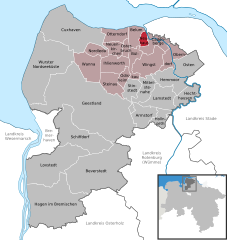Neuhaus (Oste)
| Neuhaus an der Oste | ||
|---|---|---|

Evangelical Lutheran Emmaus Church
|
||
|
||
| Coordinates: 53°48′N 09°02′E / 53.800°N 9.033°ECoordinates: 53°48′N 09°02′E / 53.800°N 9.033°E | ||
| Country | Germany | |
| State | Lower Saxony | |
| District | Cuxhaven | |
| Municipal assoc. | Land Hadeln | |
| Government | ||
| • Mayor | Georg Martens (CDU) | |
| Area | ||
| • Total | 9.86 km2 (3.81 sq mi) | |
| Elevation | 2 m (7 ft) | |
| Population (2015-12-31) | ||
| • Total | 1,186 | |
| • Density | 120/km2 (310/sq mi) | |
| Time zone | CET/CEST (UTC+1/+2) | |
| Postal codes | 21785 | |
| Dialling codes | 04752 | |
| Vehicle registration | CUX | |
| Website | www.gemeinde-neuhaus-oste.de | |
Neuhaus an der Oste (in High German, in Low Saxon: Neehuus) is a municipality in the district of Cuxhaven, in Lower Saxony, Germany.
The area of today's Neuhaus belonged to the Prince-Archbishopric of Bremen, established in 1180. In 1371 Prince-Archbishop Albert II's bailiff in Vörde erected the fortress Slikborch near today's Neuhaus at the mouth of the river Aue into the Oste, shortly before it empties into the Elbe, as a stronghold to wield power over the Land of Kehdingen and to gain a stake in the neighbouring Saxe-Lauenburgian exclave Land of Hadeln. In 1387 the free peasants from Hadeln and Kehdingen demolished the fortress Slikborch as a threat to their autonomy.
In 1404 Prince-Archbishop Otto II erected a new fortress on the right bank of the Aue, then named "dat Nygehus" (the new house), becoming the eponym for the place. However, the peasants again also destroyed this fortress in 1420. The peasants of the neighbouring municipalities forged an alliance against a new fortress in 1423. In 1435 Prince-Archbishop Baldwin II commissioned the construction of a new fortress now called castle or mansion, although his pre-predecessor had pledged not to erect another fortress. Peasants of Hadeln, Kehdingen, and Wursten attacked the fortress several times in the 15th and 16th century.
Under Prince-Archbishop Christopher the Spendthrift a number of villages tried to separate from the Prince-Archbishopric of Bremen in favour of neighbouring Saxe-Lauenburgian Hadeln. This resulted in a war between Christopher and Duke Magnus I of Saxe-Lauenburg. However, Christopher successfully suppressed the separatists and Magnus and Christopher confirmed the status quo ante bellum of the villages by a treaty in 1516. Duke Magnus, however, broke the contract and ravaged villages in the prince-archbishopric, including the fortress in Neuhaus. The castle was soon restored but around 1540 Christopher the Spendthrift pawned it with all its dues to levy to Johann von Münchhausen for 4,000 gold guilders. In 1544 the estates of the prince-archbishopric agreed to levy an extra tax to redeem the pawns in return for Christopher's moderation of his prodigality.
...
Wikipedia




